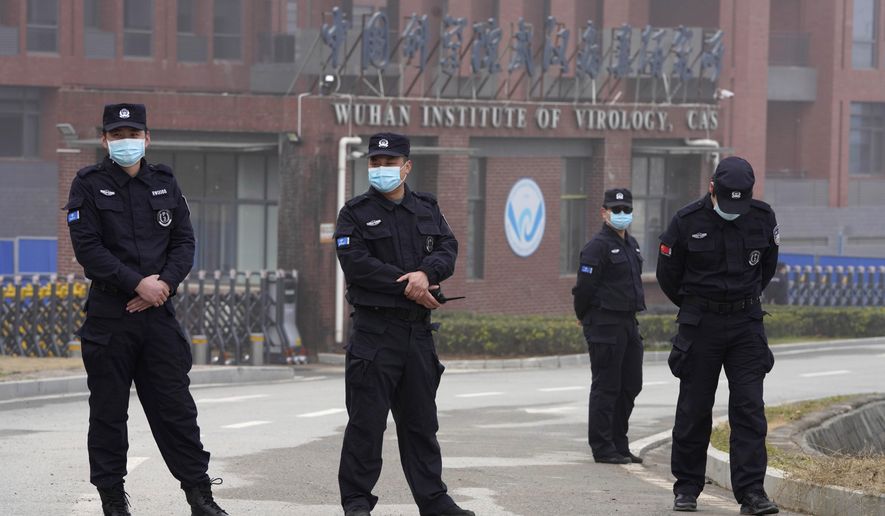Following more than a year of delays imposed by the Chinese government, a World Health Organization team probing the origin of the coronavirus visited the suspect Wuhan Institute of Virology (WIV) on Wednesday.
The WHO virology experts toured the secure laboratory at the Institute that the State Department believes was one of two potential sources for a leak of the virus that has killed more than 2 million people in the global pandemic.
Another theory is that the virus was transmitted to a host animal and spread to humans at a Wuhan wild animal market. Investigators, however, have been unable to identify the possible host animal.
The WHO team also met with the laboratory’s senior virology expert, Shi Zengli, who has been dubbed the “Batwoman of Wuhan” for her extensive research on bat coronaviruses similar to the virus that causes Covid.
“Extremely important meeting today with staff at WIV including Dr Shi Zhengli. Frank, open discussion. Key questions asked & answered,” wrote team member Peter Daszak on Twitter.
Mr. Daszak is a zoologist and president of the EcoHealth Alliance, a New York group that in the past has conducted research at the WIV, including with Ms. Shi. He also is a vocal critic of the lab leak theory.
“‘If the evidence is there, we will follow it,” he told NBC News.
The State Department disclosed the first circumstantial evidence linking the WIV to Covid in a report made public Jan. 15.
The report said the WIV is suspected of being the source of a lab leak after several lab workers were sickened with Covid-like symptoms in the autumn of 2019 – prior to the first known case of the pneumonia-like disease.
The State Department also said the institute has conducted research on a bat virus that is 96% similar to SARS-Covid-2, as the virus is called, and that studies were conducted on ways to make the virus more infectious to humans.
Last, the report revealed that, contrary to claims of institute officials, including Ms. Shi, the WIV has conducted research for the Chinese military, including experiments on lab animals.
China’s military is suspected of having a covert biological weapons program, according to a State Department report made public last year.
“Despite the WIV presenting itself as a civilian institution, the United States has determined that the WIV has collaborated on publications and secret projects with China’s military,” the report said.
“The WIV has engaged in classified research, including laboratory animal experiments, on behalf of the Chinese military since at least 2017.”
The report said the United States and other donors who funded or collaborated on research at the WIV “have a right and obligation to determine whether any of our research funding was diverted to secret Chinese military projects at the WIV.”
Any credible investigation into the virus origin requires complete and transparent access to the laboratories in Wuhan, including facilities, samples, personnel and records, the report said.
“As the world continues to battle this pandemic – and as WHO investigators begin their work, after more than a year of delays – the virus’s origin remains uncertain,” the report said.
“The United States will continue to do everything it can to support a credible and thorough investigation, including by continuing to demand transparency on the part of Chinese authorities.”
Until the State Department report, several media outlets described the possibility of the lab leak of the virus as a “conspiracy theory.” A special task force of virology experts hosted by the State Department has been deadlocked over the question of the virus origin, according to government officials familiar with the group’s work, with some 70% of the experts on the task force believing the virus leaked from a Wuhan lab.
The Chinese government has not disclosed details of its findings into the origin of the virus. Instead, Beijing officials have claimed variously that the virus was introduced into China by the U.S. Army in November 2019 or originated in southern Europe.
Chinese authorities also have said the virus was imported on the surface of frozen food, a theory most virus experts have rejected as very unlikely.
Wang Wenbin, a Chinese Foreign Ministry spokesman, did not answer when asked about U.S. claims that the virus leaked from the WIV.
“Tracing the origin of the virus is a complex scientific issue and we need to offer ample space for scientists to do their work,” he said.
Asked what was learned during the lab visit, Thea Fischer, a Danish member of the WHO team, said from her car as it left the institute: “Very interesting. Many questions.”
The WIV contains China’s sole high-security laboratory, one that was built by a French company.
The Chinese Communist Party-affiliated Global Times quoted a source close to the lab as saying “the U.S. government has never provided one piece of verifiable evidence to support this hype about the coronavirus being leaked from the lab.”
China has experienced a lab leak in the past. The SARS virus leaked in 2003 and caused one death.
• Bill Gertz can be reached at bgertz@washingtontimes.com.




Please read our comment policy before commenting.